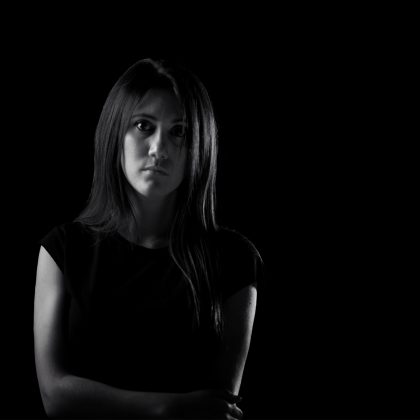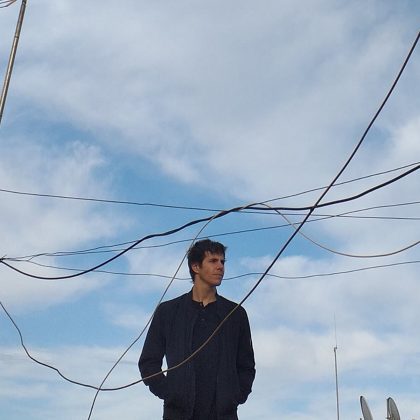Plastikman “Spastik”
The birth of our underground brand, Factory 93, not only brought on an adrenaline rush reminiscent of the renegade warehouse era of raving—on which Insomniac was founded—but it also had us thinking back to all the people, places and parties that made this whole operation possible. With that came a burning desire to crack open our collection and dust off the classic records we couldn’t live without. Through our From the Crate series, we’re breaking out seminal and obscure cuts alike, imparting some knowledge in the process.
In the early 1990s, Richie Hawtin was king of the Midwest underground.
While there might have been bigger promoters and more popular DJs, no one embodied a singular vision of music, aesthetic, and cult of personality like Richie Hawtin during the burgeoning North American rave scene of the time.
Growing up across the Detroit River in Windsor, Canada, Hawtin was part of a generation that grew up on techno originators like Juan Atkins and Derrick May, schooled on local Motown legends like the Electrifyin’ Mojo and the New Dance Show.
What became known as “Richie Parties” were Hawtin-crafted events under the banner of his Plus 8 label, where the then-plentiful abandoned buildings and industrial warehouse spread across Detroit were turned into veritable playgrounds of sound, often set in pitch-black rooms with brain-melting sound systems.
The stark, low-budget/high-concept scene gave birth to a legion of diehard fans and turned into its own scene, characterized by shaved heads and black-framed glasses in homage to Hawtin’s signature look at the time.
“Plus 8 defined, for a lot of us, not only what the sound was, but a whole set of experiences growing up,” remembered Jon Ozias, manager of Detroit’s legendary Motor nightclub back in 2000. “For those before us, there was the Music Institute, but for us, it was the Plus 8 parties, the Hard, Harder and Hardest parties. All of the events they did were like the gateway for the next generation of this scene.”
While the soundtrack was a wild mix of local and European dance records, Hawtin began developing his own sound. Applying the stripped-down stomp of Chicago ghetto-house with a sleek techno aesthetic, what would emerge would be the seeds of his most famous (and notorious) alias, Plastikman.
The legend of Plastikman quickly spread throughout the Midwest, as Hawtin would play parties across the region, often with scores of his lookalike supporters following him from show to show.
The Plastikman sound was minimalism taken to an extreme. Hard, metallic Roland-808 and 909 drum tracks fused with dark, ghostly synths and menacing 303 acid lines marked both the release of the first Plastikman full-length, Sheet One, and what would become the moniker’s signature track, “Spastik.”
Both were released in the fall of 1993, and for anyone who spent time dancing at illegal after-hours parties in the Midwest from that point on, the rattling drums of “Spastik” will instantly evoke a time and place.
“It reminds me of how hands-on the recording process was—because it was, if I remember right, a 909 and 808 drum machine. Probably some 707 in there,” Hawtin remembered of the track’s creation during a lecture at the Red Bull Music Academy in 2013. “But that was it, so it was just me jamming with those three instruments. And you’re here at the end, but you’re playing with the tuning and decays of the different snares, and also, later playing with just the EQs and using every kind of knob and button and fader on the mixer on those three instruments to try and make something that was engaging for what felt like 20 minutes.”
Contained in a taut eight minutes, “Spastik” covers a lot of territory, albeit much of it subtle. Opening with little more than a click track, the militaristic beat shifts and rolls through a whirlwind of changes conceived by the producer’s meticulous and mostly live mix.
“The original song was like much of my music that I was recording at that point—a half-an-hour, 45-minute jam. Just press start, and see where it went,” Hawtin continued. “Usually in those jam sessions, I would get a really good beginning. Then somewhere in the middle, I’d get a good jam part. Then I’d have a good ending, and that’s pretty much what happened there. I think there was a little edit at the beginning, and then there was another edit to put the end on. But pretty much, what you hear is what happened for those 35–40 minutes in my studio.”
The track was an instant sensation, providing the perfect soundtrack for the “Midwest hardcore” scene of the early ‘90s. It was reflective of the minimal and androgynous fashion, which flew in stark opposition to the bright and fantastical looks happening throughout the West Coast. It played to the psychedelic release of LSD, highly pervasive in the pre-MDMA era. “Spastik” roared out of underground party speakers with an aggressive and defiant attitude akin to Sex Pistols’ “God Save the Queen.” It was punk rock, techno style.
“That record was everywhere,” recalled producer/Technical Equipment Supply label owner Todd Osborn, during a recent interview. “It was such a defining moment. I still find that CD in the most random people’s collection, and there’s always an interesting story about how it got there. It’s not the kind of thing you’d ever hear on the radio, but the popularity of that track is hard to measure. There was a time years ago when I would make music inspired by the sound of an early Richie Hawtin party.”
Totally bucking against mainstream dance music—and even the more popular side of the early ‘90s underground—by stripping everything away and rebuilding it from the inside out, Hawtin created his own scene (and ultimately, legend) from that relentless and singular vision. And the entire blueprint can be found within the skeletal grooves of “Spastik.”
The track has been remixed numerous times over the years, most famously in the form of the 2010 Dubfire rework, which added funk and a booming kick drum into the mix, breathing new life into the tune for the next generation of dance music fans.
“I knew I wanted it to be acidic, but not Chicago acid. Not grating, either,” Hawtin explained of his initial Plastikman output in a 2016 interview. “I wanted something beautiful, soulful and trippy, like the guys in the ‘60s and ‘70s used to make. It’s not peak-time. It’s music for the end of the party, as you’re melting into the floor, which is exactly what the name ‘Plastikman’ was made to represent.”





